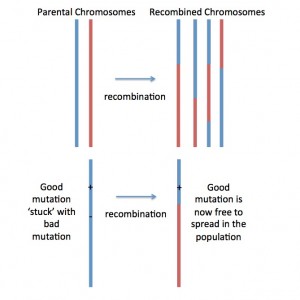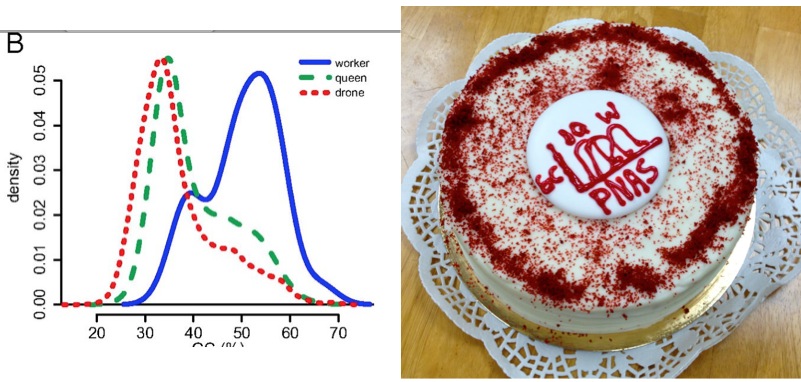Nadia awarded an Ontario Graduate Scholarship
Very happy to announce that Nadia Tsvetkov was awarded an Ontario Graduate Scholarship for 2013. Congrats Nadia!
Very happy to announce that Nadia Tsvetkov was awarded an Ontario Graduate Scholarship for 2013. Congrats Nadia!
We have a new paper out in Molecular Biology and Evolution. See the press release here.
When the honey bee Apis mellifera genome was sequenced in 2006, researchers found that the bee has fewer innate immune genes – the genes that recognize and destroy pathogens – than other solitary insects. The bee had about 30% of the innate immune genes found in flies and mosquitos. Wow! Why?
Dr. Jay Evans (USDA) and colleagues hypothesized that maybe bees have fewer pathogens, or that they can fight pathogens better with social behaviour; worker bees can groom themselves and their sisters, and they can recognize sick/dead larva and remove them from the colony.
Brock Harpur, a MSc (now PhD) student in the lab is very interested in immunity in social insects, and he decided to study the evolution of 13 innate immune genes in the honey bee. We sequenced these genes in about 40 different honey bee workers, and in one worker of the closely related Asian honey bee Apis cerana. This allowed us to discover mutations in innate immune genes within the European honey bee Apis mellifera, and between the European and the Asian honey bee (Apis mellifera vs. Apis cerana). We compared the amount of mutations in innate immune genes to those found in 20 randomly chosen genes.
The DNA sequence of a given gene codes for a specific sequence of amino acids that get folded into a 3-dimensional protein that then preforms a specific function within the cell. Mutations in a gene sequence come in two flavours: there are mutations that don’t change the amino acid sequence of the resulting protein (we call these silent mutations), and there are mutations that change the amino acid sequence of the resulting protein (we call these replacement mutations). The silent mutations – because they do not affect the shape and structure of the resulting protein – do not often affect fitness and are not ‘weeded-out’ by natural selection; silent mutations accumulated within species, and between species. However, replacement mutations will change the shape / structure of proteins, and often the resulting protein will not function optimally (if it works at all). These mutations, because they are often bad, are then rapidly removed by natural selection (because bees with these mutations do not survival as well).
Now imagine a gene sequence that was functional in an ancestor but is now no longer necessary. Replacement mutations in such genes will no longer be weeded-out by natural selection (because bees with these mutations survival normally), and these mutations can then accumulate similar to silent mutations; this process is called ‘relaxation of purifying selection or relaxation of constraint’.

When selection is relaxed (right), mutations accumulate at fast rates in gene sequences. Normally, mutations that alter the amino acid sequence of a protein will be removed by purifying selection as a large fraction of these mutations are bad (left)
This is exactly what we see when we look at most immune genes in the honey bee. When we examine silent mutations, immune genes and random genes have similar rates. However, if we examine replacement mutations, we find that immune genes have 3 to 4 higher mutations relative to random genes; this is consistent with a relaxation of purifying selection. We reckon that the same process that resulted in massive loss of innate immune genes in the bee is still acting to erode some of the remaining innate immune genes in contemporary bee populations. Our work supports Dr. Jay Evans’ idea that some aspect of social living makes an individual-based innate immune system less useful.
We have a paper out this month in Communicative and Integrative Biology on the evolution of recombination rates in social insects. This follows up on our recent PNAS paper showing a relationship between recombination, GC content, and worker biased genes in the honey bee. We now present a conceptual paper on how high recombination could have been advantageous during the initial stages of the evolution of sociality, which in turn could have affected GC content in social insects. The paper was authored by Dr Clement Kent – a postdoctoral fellow in the lab. Its an open access article, so you can download it and read it for free!
Amro
Our colleagues Drs. Hunt, Glastad, and Goodisman raised some comments about our recent article showing a relationship between recombination, GC content, and worker-baised genes in honey bees; Their comments, along with our response were published online this week in the Proceedings of the National Academy of Sciences.
Genome composition, caste, and molecular evolution in eusocial insects
Brendan G. Hunt, Karl M. Glastad, and Michael A. D. Goodisman
PNAS 2013 110 (6) E445-E446; published ahead of print February 1, 2013, doi:10.1073/pnas.1220586110
and
Reply to Hunt et al.: Worker-biased genes have high guanine–cytosine content and rates of nucleotide diversity in the honey bee
Clement F. Kent, Shermineh Minaei, Brock A. Harpur, and Amro Zayed
PNAS 2013 110 (6) E447; published ahead of print February 1, 2013, doi:10.1073/pnas.1221223110
Congratulation to Brock Harpur for winning the Canadian Association of Professional Apiculturists’ student merit award for 2013! The award recognizes outstanding achievement in the study of apiculture. More on the award here. Also see this news post from the Ontario Beekeepers’ Association
Congrats Brock – well deserved!
Why do honey bees have hairy eye balls?
Hear the answer on the Quirks Question Show on Saturday Dec. 29, at noon on CBC Radio One. You can also listen online here.
I am very happy to announce the recent publication of a collaborative review on the relationship between brain gene expression and behaviour with Dr. Gene Robinson at the University of Illinois. We reviewed a large number of studies examining changes in brain gene expression in the honey bee across a wide spectrum of behaviours, environments, and honey bee subspecies.
We showed that brain gene expression is intimately linked to behaviour and that changes in brain gene expression bring about changes in behaviour. We discuss how changes in the environment as well as changes in physiology affect bee behaviour by first affecting brain gene expression. Finally, we showed that the association between specific genes and behaviour can be highly conserved over evolutionary time, leading to common basis of behaviour across distantly related animals.
The review appeared last week in Annual Review of Genetics
Hmmm…. i am starting to have my doubts about this new grad student from Transylvania. Her work habits are a bit unusual (working at night, sleeping by day)….. But she is very productive…. some would even say that she devours other students for lunch…

Fig. 1. Recombination shuffles ‘parental chromosomes’ (red and blue), generating ‘mosaic’ or recombined chromosomes. This is how recombination makes natural selection act more effectively: Lets imagine a new beneficial mutation occurring nearby a deleterious (=bad) mutation on the blue chromosome. With no (or low) recombination, the two mutations would be stuck together… forever… and this would prevent natural selection from removing the bad mutation and spreading the good mutation. But if recombination generates a new mosaic chromosome that has the good mutation but not the bad mutation (as pictured), then the good mutation can spread by natural selection!

Worker ‘genes’ are GC rich baby! Fig 2 from our PNAS paper, in both tiff and cake formats. The Tiff format is more impactful but the cake format is tastier
So, our results show that the bee’s high recombination rate increases the evolutionary rate of genes associated with worker behaviour, which is an important finding because worker behaviour plays a major role in determining the fitness of insect colonies.
The paper was authored by postdoctoral fellow Dr. Clement Kent, and former Masters students Shermineh Minaei and Brock Harpur.
[edit March 2013]. See Faculty of 1000 recombination, comment by Hunt et al and our reply, and addendum in Communicative and Integrative Biology